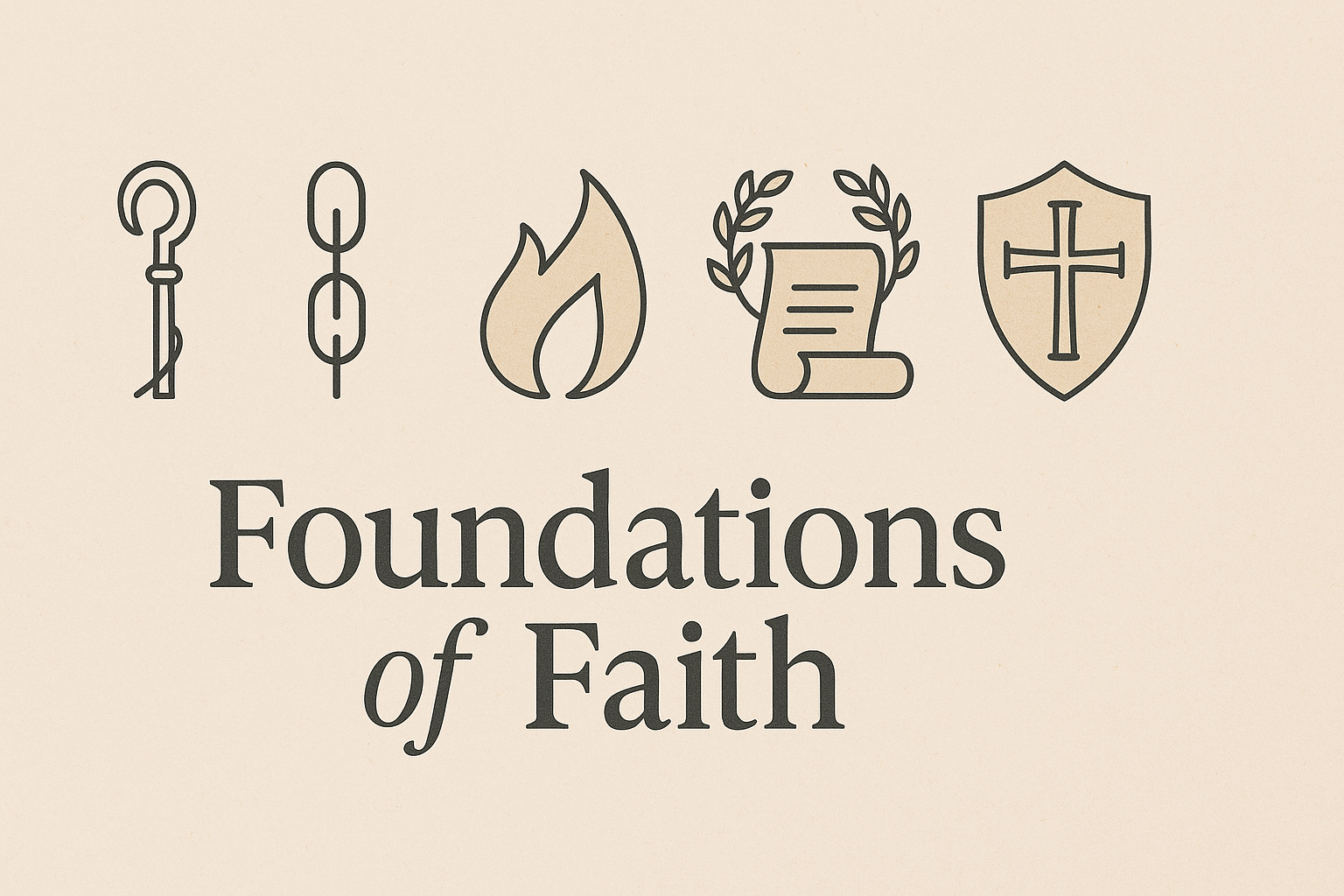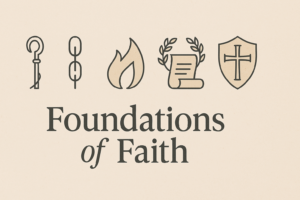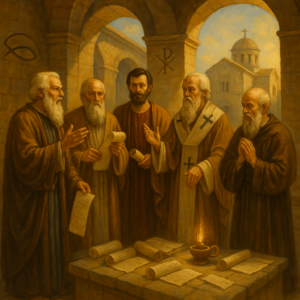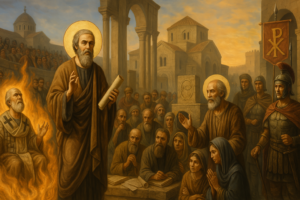Estimated reading time: 15 minutes
Key Takeaways
- The early church fathers were instrumental in shaping Christianity after the apostolic age.
- Their teachings can transform and deepen your faith today.
- They addressed crucial issues like church unity, combating heresies, and interpreting Scripture.
- Key figures include Clement of Rome, Ignatius of Antioch, Polycarp of Smyrna, Justin Martyr, and Irenaeus.
- Accessing their writings can enrich your spiritual journey and understanding.
Introduction
The early church fathers were pivotal figures who shaped Christianity in its formative years. These theologians, bishops, and spiritual leaders emerged after the apostolic age and worked tirelessly to define, defend, and spread the Christian faith throughout the Roman Empire and beyond.
These remarkable men served as bridges between the time of Jesus and the apostles to the established Church we recognize today. Their writings clarified doctrines, combated false teachings, and established the practices that would define Christianity for centuries.
In this exploration of these foundational figures, we’ll uncover five powerful secrets from their lives and teachings that can transform your faith today. Their wisdom, born in times of persecution and theological uncertainty, offers timeless insights for modern believers seeking deeper understanding.
Historical Overview of the Early Church Fathers
The Timeline of Apostolic Church Fathers
The story of the early church fathers begins with those known as the apostolic church fathers – men who had direct contact with Jesus’s apostles. They emerged in the late first century, as the original apostles were passing from the scene.
The earliest of these fathers included:
- Clement of Rome: Likely the third bishop of Rome (after Peter). He wrote an influential letter to the Corinthian church around 95 AD.
- Ignatius of Antioch: Bishop of Antioch who wrote seven letters while being transported to Rome for execution around 110 AD.
- Polycarp of Smyrna: A disciple of the apostle John who led the church in Smyrna until his martyrdom around 155 AD.
These early leaders focused primarily on church unity, proper worship, and maintaining the authentic teachings passed down from the apostles.
Following the apostolic fathers came the apologists of the second century, including Justin Martyr and Irenaeus, who defended Christianity against both pagan critics and heretical teachings within the church.
The third and fourth centuries saw the rise of systematic theologians like Tertullian, Origen, and later Augustine, who developed comprehensive frameworks for understanding Christian doctrine.
From Clement to Augustine: Key Figures and Developments
The period from Clement of Rome to Augustine represents a remarkable evolution in Christian thought and practice. During these crucial centuries, the church moved from a persecuted minority to the dominant religion of the Roman Empire.
Key figures in this progression included:
- Clement of Rome (late 1st century): Emphasized church order and apostolic succession
- Ignatius of Antioch (early 2nd century): Stressed the authority of bishops and the importance of church unity
- Polycarp (69-155 AD): Preserved apostolic teachings and demonstrated faithfulness through martyrdom
- Justin Martyr (100-165 AD): Used Greek philosophy to defend Christian beliefs to pagan intellectuals
- Irenaeus (130-202 AD): Combated Gnosticism and established criteria for recognizing authentic Scripture
- Tertullian (155-240 AD): Developed technical theological language and defended Christian distinctiveness
- Origen (185-254 AD): Created systematic biblical interpretation and theological exploration
- Athanasius (296-373 AD): Championed Trinitarian doctrine against Arianism
- Basil the Great, Gregory of Nazianzus, and Gregory of Nyssa (4th century): Developed precise Trinitarian theology
- Augustine (354-430 AD): Created comprehensive frameworks for understanding sin, grace, and salvation
Each of these fathers responded to specific challenges of their time while building upon the work of their predecessors.
Understanding Early Church Fathers’ History
The early church fathers’ history is inseparable from the broader historical context of the Roman Empire from the first through fifth centuries. These leaders guided the church through:
- Waves of brutal persecution under various Roman emperors
- The dramatic shift following Constantine’s conversion in the early 4th century
- Intense theological debates that defined core Christian doctrines
- The fall of Rome and transition to the medieval period
The fathers weren’t merely academic theologians – they were pastors, bishops, and leaders guiding real communities through real challenges. Many endured imprisonment, torture, exile, and martyrdom for their beliefs.
Their historical context matters because it shaped their priorities. During persecution, they emphasized faithfulness and proper teaching. As Christianity gained imperial favor, they worked to clarify doctrinal boundaries and establish church structures.
Through it all, they maintained a commitment to apostolic teaching, interpreting Scripture faithfully, and preserving the essence of the Christian gospel despite changing cultural circumstances.
Key Early Church Fathers and Their Writings
Exploring Ignatius of Antioch Writings
Ignatius of Antioch stands as one of the most significant early Christian voices. As bishop of Antioch in Syria during the early second century, he wrote seven authentic letters while being transported to Rome for execution around 110 AD.
His writings reveal several key themes that provide a window into early Christian priorities:
- Church Unity: Ignatius repeatedly urged Christians to maintain unity under their bishop. He wrote to the Ephesians, “Be eager to maintain the unity of the Spirit in the bond of peace. There is one body and one Spirit.”
- Episcopal Authority: He emphasized the role of the bishop as the church’s central authority, surrounded by presbyters (elders) and deacons. This three-tier leadership structure became normative in the early church.
- Combating Heresies: Ignatius confronted two major threats – docetism (the belief that Jesus only appeared human but wasn’t truly flesh) and Judaizing tendencies. He insisted that Jesus was “truly born, both ate and drank, was truly persecuted under Pontius Pilate… truly raised from the dead.”
- The Eucharist: He called the Eucharist “the medicine of immortality” and stressed its importance for Christian unity and identity.
Perhaps most movingly, Ignatius’s letters reveal his willingness to face martyrdom. To the Romans, he pleaded: “Allow me to be eaten by the beasts, through whom I can attain to God… I am God’s wheat, and I am to be ground by the teeth of wild beasts, so that I may become the pure bread of Christ.”
The Significance of Polycarp of Smyrna Writings
Polycarp of Smyrna provides a direct link to the apostolic age. As a disciple of the apostle John who lived from approximately 69-155 AD, he represents a living connection to Jesus’s original followers.
Though his writings are limited primarily to a single letter to the Philippians, Polycarp’s significance extends far beyond this text. His letter reveals:
- A deep familiarity with New Testament writings, quoting or alluding to multiple books
- Practical moral instruction for Christian living
- Warnings against false teachings that denied the reality of Jesus’s incarnation and resurrection
- Emphasis on following the examples of Christ and the apostles
However, the most powerful testimony of Polycarp comes from the account of his martyrdom, preserved in “The Martyrdom of Polycarp.” When commanded to renounce Christ at age 86, Polycarp famously replied:
“Eighty-six years I have served Christ, and He never did me any wrong. How can I blaspheme my King who saved me?”
This courage in the face of death demonstrated the depth of early Christian commitment and inspired generations of believers. Even his executioners marveled at his dignity and faith as he was burned at the stake.
The Apologetic Work of St. Justin Martyr Writings
St. Justin Martyr (100-165 AD) stands as Christianity’s first great apologist – a defender of the faith to the wider intellectual world. A former Platonist philosopher who converted to Christianity as an adult, Justin uniquely bridged the worlds of Greek philosophy and Christian revelation.
His major writings include:
- First Apology: Addressed to Emperor Antoninus Pius, defending Christians against charges of atheism and immorality
- Second Apology: A shorter work addressing specific cases of Christian persecution
- Dialogue with Trypho: A record of Justin’s debate with a Jewish scholar about how Jesus fulfills Old Testament prophecies
What makes Justin’s work groundbreaking is his approach in presenting Christianity as the fulfillment of the best of pagan philosophy, not merely its rejection. Key themes in his writings include:
- The concept of the Logos (Word) as a bridge between Greek philosophical thought and Christian revelation
- Detailed descriptions of early Christian worship, including one of our earliest accounts of baptism and the Eucharist
- Defense of Christians as loyal citizens who nevertheless refused to worship the emperor or participate in pagan rituals
- Arguments that Christianity fulfilled Old Testament prophecies and represented the true fulfillment of Jewish hopes
Justin eventually paid the ultimate price for his faith, being beheaded in Rome around 165 AD after refusing to sacrifice to pagan gods – truly living up to his title “Martyr” (witness).
Understanding Irenaeus Writings Against Heresies
Irenaeus of Lyons (130-202 AD) emerged as Christianity’s first great systematic theologian. As bishop of Lyons in Gaul (modern France), he had studied under Polycarp, creating a direct link to the apostolic age.
His masterwork, “Against Heresies” (Adversus Haereses), written around 180 AD, stands as the most important Christian theological treatise of the second century. In this five-volume work, Irenaeus:
- Provided detailed descriptions of Gnostic teachings, a valuable historical record
- Established criteria for identifying authentic apostolic teachings
- Defended the unity of the Old and New Testaments against those who rejected the Jewish Scriptures
- Emphasized the public nature of true Christian teaching versus secretive Gnostic claims
- Promoted the “rule of faith” – core doctrines handed down from the apostles
- Developed the concept of apostolic succession – the idea that true teaching is preserved through bishops ordained in direct succession from the apostles
Beyond combating heresy, Irenaeus’s writings made positive theological contributions, including:
- The concept of “recapitulation” – how Christ reverses Adam’s fall and restores humanity
- Early articulations of Mary as the “New Eve” whose obedience contrasted with Eve’s disobedience
- Defense of the four canonical Gospels against those who accepted only one or added spurious gospels
- Developing the concept of the Church as the center of God’s work in the world
Irenaeus’s clear thinking and pastoral concern established patterns of theological reflection that would influence the church for centuries.
Comparing Tertullian and Origen: Contrasting Approaches
Tertullian (155-240 AD) and Origen (185-254 AD) represent two brilliant but contrasting approaches to early Christian theology, one from the Latin West and one from the Greek East.
Tertullian, based in Carthage (North Africa), brought a lawyer’s precision to theology and is often called the father of Latin theology. His sharp wit and penchant for memorable phrases (like “What has Athens to do with Jerusalem?”) make his writings distinctive. His contributions included:
- Developing Latin theological vocabulary, including the term “Trinity” (trinitas)
- Defending the full humanity and divinity of Christ against heretical views
- Articulating a moral rigorism that emphasized Christian distinctiveness from pagan society
- Later association with the Montanist movement, which claimed new prophetic revelations
By contrast, Origen of Alexandria represented a more philosophical approach to theology, seeking to integrate Christian teaching with the best of Greek philosophical wisdom. His vast output included:
- The Hexapla – a six-column comparison of different versions of the Old Testament
- De Principiis (On First Principles) – the first systematic Christian theology
- Extensive biblical commentaries that pioneered allegorical interpretation
- Exploration of universal salvation and pre-existence of souls that later drew controversy
The differences between these giants highlight the diverse approaches within early Christianity:
| Tertullian | Origen |
|---|---|
| Legal, precise language | Philosophical speculation |
| Emphasized Christian distinctiveness | Sought integration with Greek thought |
| Western, Latin tradition | Eastern, Greek tradition |
| Practical and ethical focus | Theoretical and mystical focus |
Despite their differences, both made immeasurable contributions to Christian thought and demonstrated the intellectual vitality of early Christianity.
Writings and Contributions of the Early Church Fathers
The Significance of Apostolic Fathers Writings
The apostolic fathers writings serve as our earliest window into post-biblical Christianity. These texts, written between roughly 95-150 AD, show how the first generations after the apostles understood and applied Christian teaching.
What makes these early Christian writings so valuable is their chronological proximity to the apostolic age. Key documents include:
- First Clement: Written around 95 AD from the church in Rome to the church in Corinth, addressing division and emphasizing proper order in the church
- The Didache: An early church manual covering baptism, fasting, prayer, the Eucharist, and Christian ethics
- Letters of Ignatius: Seven authentic letters written while journeying to martyrdom in Rome
- The Epistle of Polycarp to the Philippians: Practical moral instruction from a disciple of John
- The Shepherd of Hermas: An apocalyptic work featuring visions, commands, and parables
- Epistle of Barnabas: An allegorical interpretation of the Old Testament
- Papias Fragments: Preserved comments on the origins of the Gospels
These writings reveal several important features of early Christianity:
- Regular use of New Testament writings as authoritative, showing the early formation of the Christian canon
- Emphasis on church unity and proper leadership structures
- Concern for moral living and Christian distinctiveness
- Defense against early heresies, particularly docetism (denial of Christ’s physical body)
- Development of regular worship patterns, including the Lord’s Day, baptism, and Eucharist
While not considered Scripture, these Catholic church fathers writings provide invaluable historical insight into how the earliest Christians understood their faith.
Accessing Early Church Fathers Online
Today, the treasures of the early church fathers are more accessible than ever before thanks to digital resources. Several excellent websites offer free access to complete collections of patristic literature:
- Christian Classics Ethereal Library (CCEL): Offers the complete 38-volume Ante-Nicene, Nicene, and Post-Nicene Fathers series.
- New Advent: Provides the Catholic Encyclopedia plus a searchable collection of fathers’ writings organized alphabetically by author.
- Early Christian Writings: Specializes in the earliest Christian texts (1st and 2nd centuries), offering historical context and scholarly introductions.
- Internet Christian Library: Contains the complete Church Fathers collection with a straightforward interface.
- EWTN Library: Houses a substantial collection of patristic writings organized by author and period.
For those wanting to study systematically, consider these approaches:
- Chronological study: Start with the apostolic fathers and work forward through history
- Topical study: Examine how different fathers addressed specific doctrines like the Trinity or Christology
- Single-author deep dive: Focus on one father’s complete works to understand their unique contribution
- Scripture-based study: Look at how different fathers interpreted particular biblical passages
Many of these sites also offer secondary resources like introductions, historical context, and study guides to help modern readers navigate these ancient texts.
Early Church Fathers Commentary on Scripture
The early church fathers approach to Scripture differs significantly from modern methods. Their commentary on Scripture reveals interpretive strategies that modern readers might find surprising yet enriching.
Several distinctive features characterized patristic biblical interpretation:
- Christological focus: The fathers consistently read the Old Testament as pointing to Christ.
- Typological interpretation: They saw events, persons, and institutions of the Old Testament as “types” or foreshadowings of New Testament realities.
- Allegorical reading: Many fathers, especially from the Alexandrian tradition, looked for deeper spiritual meanings beyond the literal text.
- Moral application: Fathers like John Chrysostom emphasized practical lessons for Christian living from Scriptural narratives.
- Rule of faith: They interpreted difficult passages in light of the church’s core doctrinal beliefs, not in isolation.
Specific examples of patristic biblical interpretation include:
- Augustine’s extensive commentary on the Psalms, viewing them as the voice of Christ and his Church
- John Chrysostom’s detailed homilies on Matthew’s Gospel and Paul’s letters
- Origen’s pioneering work in textual criticism through his Hexapla
- Athanasius’s defense of Christ’s divinity through careful exegesis of passages like John 10:30
While modern biblical scholarship has developed additional tools, the fathers’ Christ-centered and spiritually rich approach continues to offer valuable insights for contemporary believers.
Frequently Asked Questions
Q: Who were the early church fathers?
A: The early church fathers were influential theologians, bishops, and leaders in the early centuries of Christianity who shaped doctrine, combated heresy, and guided the church through its formative years.
Q: Why are the writings of the early church fathers important?
A: Their writings provide insight into the beliefs and practices of early Christians, help interpret Scripture, and offer timeless wisdom relevant to modern faith.
Q: How can I access the works of the early church fathers?
A: Many of their works are available online for free through resources like the Christian Classics Ethereal Library and other websites dedicated to early Christian writings.
Q: What is the significance of apostolic succession mentioned by the fathers?
A: Apostolic succession is the belief that church authority is derived from the apostles through a continuous line of bishops, ensuring doctrinal purity and unity.
Q: Did the early church fathers all agree on theological issues?
A: While they shared core beliefs, there were differences in interpretation and emphasis. These debates contributed to the development and clarification of Christian doctrine.




